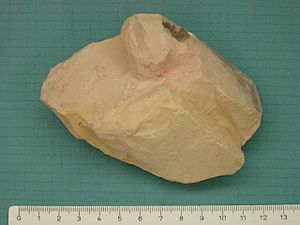Pica (disorder) facts for kids
Pica is an eating disorder where a person wants to eat things that are not normal to eat. These are often things that are not considered food at all. For example, someone with pica might want to eat dirt, rocks, hair, or even paint. Sometimes, people with pica also have a strong desire to eat unusual forms of regular food, like uncooked potatoes or plain flour. Pica is more common in young children and pregnant women. It can also affect people with certain developmental disabilities.
Contents
What is Pica?
Pica is a condition where a person regularly eats things that are not food. To be diagnosed with pica, this eating behavior must last for at least one month. It also needs to be unusual for the person's age and culture. For example, babies often put non-food items in their mouths, but this is a normal part of their development. Pica is different because it's a strong, ongoing desire to eat these items.
What do people with Pica eat?
People with pica can eat many different non-food items. The specific things they eat can vary greatly. Some common examples include:
- Dirt or clay
- Ice
- Hair or cloth
- Paint chips
- Soap
- Paper
- Starch (like laundry starch or cornstarch)
- Chalk
- Ashes or cigarette butts
It's important to remember that eating these items can be very dangerous. They might contain harmful chemicals or cause blockages in the stomach or intestines.
Why does Pica happen?
The exact reasons why pica develops are not always clear. However, several factors can increase the risk of someone having pica:
- Nutrient deficiencies: Sometimes, pica is linked to a lack of important nutrients in the body. For example, a shortage of iron or zinc can sometimes lead to cravings for non-food items like dirt or clay.
- Mental health conditions: Pica can occur alongside other mental health conditions, such as autism spectrum disorder, intellectual disability, or schizophrenia.
- Stress or trauma: In some cases, pica might be a way for a person to cope with stress, anxiety, or past trauma.
- Pregnancy: Pregnant women sometimes develop pica, often craving ice, dirt, or clay. This is thought to be related to changes in their body's needs during pregnancy.
- Cultural practices: In some cultures, eating certain non-food items (like specific types of clay) is a traditional practice. However, this is different from pica, which is a disorder.
How is Pica treated?
Treating pica usually involves a few different approaches. The main goals are to stop the person from eating harmful items and to address any underlying causes.
- Medical check-up: The first step is often a visit to a doctor. The doctor will check for any nutrient deficiencies, like low iron levels. If a deficiency is found, supplements can be given.
- Behavioral therapy: This type of therapy helps people change their eating habits. A therapist might teach strategies to avoid eating non-food items. They can also help identify triggers that lead to the cravings.
- Environmental changes: For young children or people with developmental disabilities, it's important to make their environment safe. This means removing access to harmful non-food items.
- Addressing underlying conditions: If pica is linked to another mental health condition, treating that condition can often help reduce the pica symptoms.
With the right support and treatment, many people with pica can learn to manage their cravings and stop eating non-food items.
See also
 In Spanish: Pica (enfermedad) para niños
In Spanish: Pica (enfermedad) para niños


